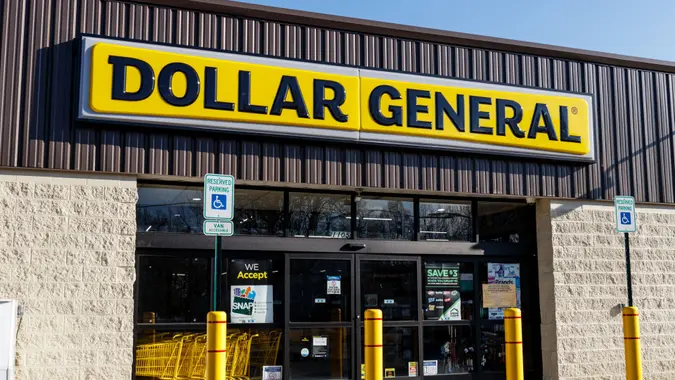Medicare Part B Premium: How Much It Will Go Up in 2024 and Why

Commitment to Our Readers
GOBankingRates' editorial team is committed to bringing you unbiased reviews and information. We use data-driven methodologies to evaluate financial products and services - our reviews and ratings are not influenced by advertisers. You can read more about our editorial guidelines and our products and services review methodology.

20 Years
Helping You Live Richer

Reviewed
by Experts

Trusted by
Millions of Readers
Every new year brings changes, and of course, this year is no different. If you’re a Medicare Part B enrollee, you may have heard about increases in the cost of premiums you’ll have to pay in 2024. It’s important to stay up to date about these changes so you can plan for how much more you’ll have to pay out of pocket.
Learn More: 3 Ways To Recession-Proof Your Retirement
Keep reading to learn about the changes coming to the monthly Medicare Part B premium and why coverage and costs are changing this year.
Changes to Medicare Part B
Medicare Part B covers beneficiaries for a range of healthcare services, including doctor visits, outpatient care, home health care, medical equipment, and other medical services that aren’t typically covered under Medicare Part A.
In October, the Centers for Medicare & Medicaid Services, or CMS, announced updated costs for Medicare for 2024 that affect Part B premiums and coverage. The changes include updated premiums, deductibles and coinsurance, and also affect Medicare Part A as well as some adjustments to income-related monthly rates for Medicare Part D premiums.
How Much Will Medicare Premiums Be in 2024?
This year, the monthly premium for Medicare Part B will go up to $174.70, an increase of $9.80 from the Medicare Part B premium in 2023. The yearly deductible for Medicare Part B enrollees is also changing from $226 to $240, which means you’ll be paying $14 more than last year.
The exact amount you’ll have to pay can vary depending on your income and other factors. While these increases in out-of-pocket expenses may seem small to some people, those with Medicare coverage typically have fixed or low incomes, so any change to their budget could impact their access to housing and food.
Why Are Medicare Costs Increasing?
Every year, the costs for Part B of Medicare, including your premium and deductible, are determined by guidelines set out in the Social Security Act. So, what’s causing these changes?
Many different factors come into play. This year’s increase in the standard premium and deductible for Part B is primarily due to an anticipated rise in healthcare costs. While the expected increase in healthcare spending over the next few years is the major driver, some tweaks made to the payment policies under the Hospital Outpatient Prospective Payment System for prescription drug coverage from 2018 to 2022 also play a role.
This program paid for prescription medications administered by certain hospitals. These hospitals, which cater to a higher proportion of disadvantaged patients, faced issues with reimbursement rates that caused them to lose a significant amount of money. The Supreme Court ruled that the changes to the drug payment policy of the Hospital Outpatient Prospective Payment System were unlawful, so to compensate for the reimbursement issues, the CMS proposed these increased payments.
Changes like these may influence anyone enrolled in Medicare Part B, as well as the healthcare industry and how these costs are calculated. If you’re a Medicare beneficiary, you might need to rework your healthcare budget to accommodate these new costs.
What Is the Donut Hole for 2024?
The “donut hole” in Medicare Part D refers to a coverage gap that occurs once you and your insurance have paid for a certain dollar amount of prescription medication. You’ll still have to pay your deductible during the initial period of Part D coverage, but after the total costs of your prescriptions reach $5,030, you’ll enter the donut hole. If there’s a silver lining here, it’s that this is $370 more than Medicare Part D paid in the initial coverage stage in 2023.
After that, you’ll have to pay more of your prescription costs until you reach the “catastrophic coverage” limit . The exact amount you’ll be out of pocket differs based on your plan, the medications you’re taking and other factors, such as Medicare’s “Extra Help” programs, if you choose to enroll in those.
The coverage gap ends after the total year-to-date cost of your medications reaches $8,000. From that point forward, Medicare Part D will cover the costs for all of your prescriptions for the remainder of the year.
Some Medicare Part D plans offer “gap coverage” that will help cover costs, but these plans may be limited to specific medications, and you may have to pay higher plan premiums for this additional coverage. You can compare the different plans available at Medicare.gov.
Our in-house research team and on-site financial experts work together to create content that’s accurate, impartial, and up to date. We fact-check every single statistic, quote and fact using trusted primary resources to make sure the information we provide is correct. You can learn more about GOBankingRates’ processes and standards in our editorial policy.
- CMS.gov. 2023. "2024 Medicare Parts A & B Premiums and Deductibles."
- SSA. "Apply for Medicare Part D Extra Help program."
- The HIll. 2023. "Medicare Part B premiums to rise by 6 percent in 2024."
- Medicare. "Costs in the coverage gap."
- Medicare. "Catastrophic coverage."
- Medicare. "5 ways to get help with prescription costs."
 Written by
Written by  Edited by
Edited by 

























